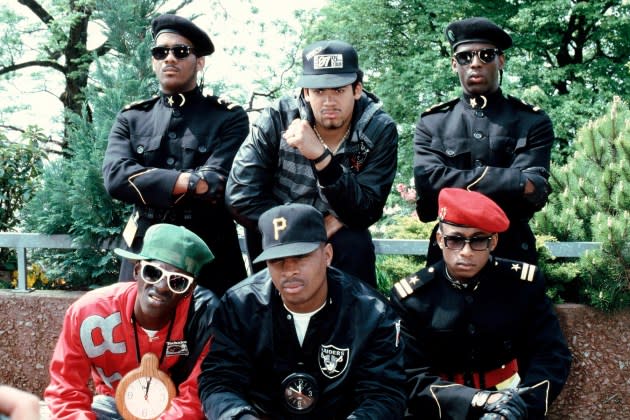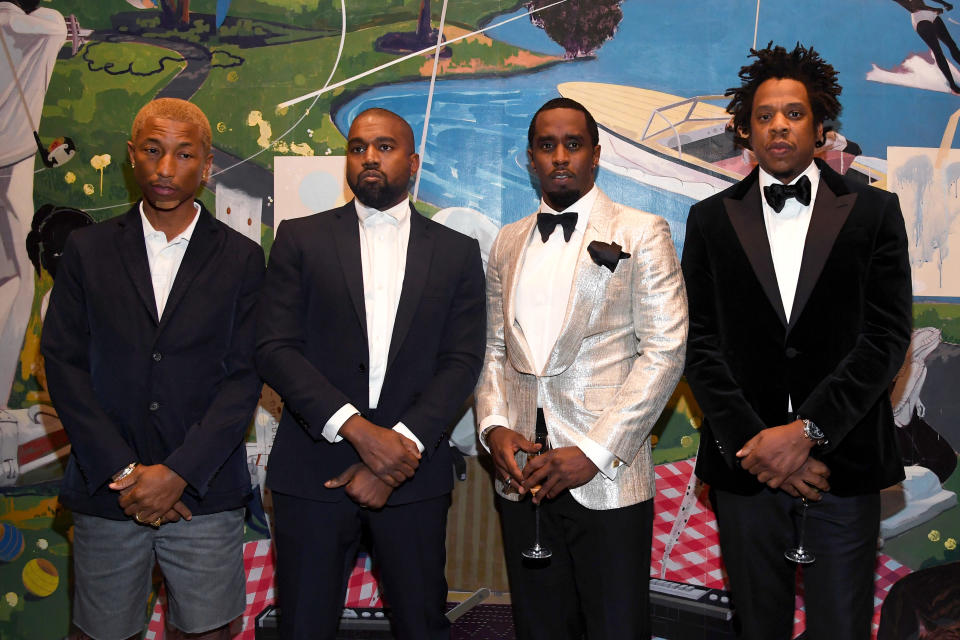‘Fight the Power’ Misses How Mainstream Rappers Became the Power
- Oops!Something went wrong.Please try again later.
- Oops!Something went wrong.Please try again later.
- Oops!Something went wrong.Please try again later.
- Oops!Something went wrong.Please try again later.
- Oops!Something went wrong.Please try again later.

At the outset of PBS’ docuseries Fight the Power: How Hip-Hop Changed the World, Chuck D asserts, “[In 2020], the Black Lives Matter protests wouldn’t have happened if it wasn’t for hip-hop.” It’s a lofty statement, as anti-establishment organizing and revolt have existed since Black people were brought to America. Hip-hop has augmented social movements since its 1973 founding; as Lupe Fiasco notes in the finale of the four-part series, ”Hip-hop is gonna supply you the theme song for the moment.”
Fight the Power does a strong job of chronicling how rappers became Black America’s cultural spokespeople through protest anthems that serve as some of society’s most resonant sociopolitical statements. Executive producer Chuck D says he was drawn to the docuseries because it relied not just on scholars and cultural critics to tell the story, but artists like Ice-T, Fat Joe, Melle Mel, Lupe Fiasco — and himself — to speak to how the times compelled their social commentary.
More from Rolling Stone
'Chowchilla': When a School Bus Full of Kids Mysteriously Disappeared
'Love Has Won': The Deadly Cult Led by the Spirit of 'Robin Williams'
Series directors Yemi Bamiro and Todd Williams were tasked with packing 50 years of history into roughly 4 hours. They smoothly guide us through hip-hop’s timeline, starting with a slow-burn introductory episode highlighting New Yorkers’ dire need for creative expression. This proves the series’ strongest hour, with rap pioneers DMC, KRS-One and Chuck D recounting the genesis of the culture. DMC contextualizes how the poverty-stricken morass of ‘70s New York urged youth like him to seek “anything that could make me feel stronger than my environment.” Most fans are aware of the four elements of hip-hop: rapping, DJing, graffiti and breakdancing. KRS-One astutely articulates that these were four different communities of individuals that eventually coalesced and collaborated. Some of us take hip-hop for granted nowadays, but the first episode emphasizes that the community was formed as a cathartic release amid systemic oppression.
The docuseries traces hip-hop’s evolution amid key moments in history, from Shirley Chisholm and Jesse Jackson’s symbolic presidential campaigns to Obama’s White House win in 2008. 9/11, Trayvon Martin and the rise of Black Lives Matter, Rodney King and the LA riots, as well as the MAGA plague, are all viewed through the lens of the hip-hop generation. The doc works best when it amplifies individual artists, contextualizing how their work spoke to a societal ill. In Episode Two, a sequence on the 1994 crime bill (replete with footage of Joe Biden’s racist fearmongering), references artists like Tupac rapping about jail, before transitioning into a wider segment on Tupac, giving the militant icon the solo treatment he deserves.
Crack cocaine flooded the streets during the Reagan era, and the docuseries examines not only how it fueled America’s carceral state, but also the hip-hop world’s response to it. Chuck D explains that Public Enemy created “Night of the Living Baseheads” because they wanted to make doing drugs seem “ugly and dirty,” underscoring hip-hop’s political value. While Nancy Reagan’s “Just Say No” campaign and other sanctimonious infomercials failed to reach the youth, hip-hop could. Elsewhere, USC Professor Jody Armour revisits when songs like “Fuck the Police” made anti-police sentiment reach folks siloed in the suburbs who’d never otherwise be privy to it, noting, “You start to recognize that there are alternative perspectives on the police… that’s inviting you to adopt a new perspective. That’s what great art does.”
The doc similarly spotlights Melle Mel’s “The Message,” Ice-T’s “6 ‘N the Mornin’” and “Cop Killer,” as well as, of course, Public Enemy’s “Fight the Power.” A man captured on the street calls Public Enemy “alarm clock music” meant to wake people up. Fight the Power also does a fine job of pushing back against the reductive perception that violent rap lyrics are the cause of real-world violence, with Ice-T and Chuck D reasoning that violent lyrics merely reflect the artist’s conditions, and are thus inherently political in their own right. “Every single utterance out of the mouths of young Black men, especially in rap music, in the ‘80s and the ‘90s, had the tone of resistance,” offers Chuck D. “Even if they wasn’t sayin’ it, it was felt. It was like, ‘How could I be better? How could I climb out of this?’”
Another of Fight the Power’s bright spots sees both men and women take hip-hop to task for its misogyny, admitting that the deluge of ‘90s slurs and misogynoir were a blight on the genre. The discussion would have been even more effective if it incorporated male artists reflecting on why they demeaned women so heavily in their lyrics, but nonetheless comes across as a moment of accountability. The documentary needed more of these moments in order to provide a full audit of hip-hop politics.
When Chuck D makes his aforementioned statement about “resistance,” songs like Eric B & Rakim’s “Follow the Leader” and Jungle Brothers’ “Done by the Forces of Nature” are invoked to hammer home his point. But in a later episode, Professor Karsonya Wise-Whitehead of Loyola University Maryland says she “feels like the music turned outward” (or invoked more social commentary) around the turn of the century, but the doc plays Dead Prez’s “Police State” and fails to showcase any other songs that drive home her point. Is that a creative oversight, or inadvertent commentary on the dearth of Y2K rap hits with radical messaging?

In the fourth episode, music journalist Rodney Carmichael reveals that it was harder for corporations to market defiant, radical acts in the vein of Public Enemy to middle America, so the mainstream became overloaded with depictions of “cats with nice cars, girls, and cats with fancy clothes.” Chuck D also contends that for newly-rich artists, “it’s bigger [business], but when you got power it comes with responsibility.” This discussion should have delved deeper by interrogating the reality of corporations profiting off of Black trauma incurred by conditions they’re not trying hard enough to uproot, and pondering whether the genre’s biggest figures are navigating their power in ways that truly benefit the lower class that the spirit of hip-hop was built on.
Many critics believe mainstream rap became less radical in the 2000s, as the genre’s biggest acts grew into wealthy figures increasingly distanced from the struggles they once experienced. Perhaps the docuseries could have explored Jay-Z’s “Moment of Clarity,” wherein he explored this dynamic, rhyming, “Truthfully I wanna rhyme like Common Sense / But I did 5 mill’ – I ain’t been rhyming like Common since,” and surmises, “I can’t help the poor if I’m one of them / So I got rich and gave back, to me that’s the win-win.”
The last episode chronicles Jay-Z, Jeezy and Diddy’s stumping for Obama, but it doesn’t acknowledge people’s legitimate concerns that too many Black celebrities are stumping for a DNC who abide by Joe Biden’s “‘you ain’t Black” if you don’t for me edict. One of the show’s talking heads should have explicitly asked whether artists should put more demands on their co-signs.
That would have properly contextualized the docuseries’ final chapter: the 2020 uprising. The system found itself in the world’s collective crosshairs after Breonna Taylor and George Floyd’s police killings, but activists were also demonstrating against the power structure as a whole, including the so-called Black elite who collude with the establishment to maintain an inequitable status quo. Killer Mike opens the doc by urging Atlanta residents to “plot, plan, organize, [and] mobilize.” But the clip is from a press conference where he and fellow rapper T.I. also told Atlanta residents to halt their protesting in the midst of the 2020 George Floyd uprising. An entertainer parroting Big Brother directives is a tenuous way to open a piece about an anti-establishment culture. And that’s to say nothing of Mike’s troubling advocacy for vote-suppressing Georgia Governor Brian Kemp. They did manage to acknowledge the on-the-ground demonstrations of artists like Bun B, Chance the Rapper and Raz Simone, who told a crowd, “You don’t have to call 911 anymore. You call us, the people.” But it should have been acknowledged how exceptional artists like he and Noname’s communal ethos is.
In 2010, Chuck D chastised Jay-Z and Kanye’s luxury opus Watch the Throne, saying that “Hip-hop celebrates those who wanna make a killing instead of a living. I like those guys, but they make me laugh sometimes because I don’t get who they’re here for, other than themselves.” Fight the Power needed more of that energy. The docuseries is fundamentally an homage to protest anthems, but once it begins highlighting how rich artists are getting, and the artistic shift that occurred due to rap’s corporatization, they opened the door to further critique the genre’s capitalist ethos. It’s great that hip-hop put artists and others in positions to feed their families via creative expression. But today’s chase-the-wealth mentality only means that you’re vying to become the very power Chuck D sought to fight against.
Best of Rolling Stone

